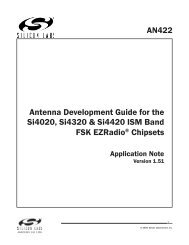C8051F326/7 - Silicon Labs
C8051F326/7 - Silicon Labs
C8051F326/7 - Silicon Labs
Create successful ePaper yourself
Turn your PDF publications into a flip-book with our unique Google optimized e-Paper software.
6.4. Power Management Modes<br />
<strong>C8051F326</strong>/7<br />
The CIP-51 core has two software programmable power management modes: Idle and Stop. Idle mode<br />
halts the CPU while leaving the peripherals and clocks active. In Stop mode, the CPU is halted, all interrupts,<br />
are inactive, and the internal oscillator is stopped (the voltage regulator, low frequency oscillator, and<br />
external clock remain in their selected state). Since clocks are running in Idle mode, power consumption is<br />
dependent upon the system clock frequency and the number of peripherals left in active mode before<br />
entering Idle. Stop mode consumes the least power. Figure 6.13 describes the Power Control Register<br />
(PCON) used to control the CIP-51's power management modes.<br />
Although the CIP-51 has Idle and Stop modes built in (as with any standard 8051 architecture), power<br />
management of the entire MCU is better accomplished through system clock and individual peripheral<br />
management. Digital peripherals, such as timers or UART, draw little power when they are not in use. Turning<br />
off the oscillators lowers power consumption considerably; however a reset is required to restart the<br />
MCU.<br />
The internal oscillator can be placed in Suspend mode (see Section “10. Oscillators” on page 71). In Suspend<br />
mode, the internal oscillator is stopped until a non-idle USB event is detected, or the VBUS input signal<br />
matches the polarity selected by the VBPOL bit in register REG0CN (Figure 5.1 on Page 34).<br />
6.4.1. Idle Mode<br />
Setting the Idle Mode Select bit (PCON.0) causes the CIP-51 to halt the CPU and enter Idle mode as soon<br />
as the instruction that sets the bit completes execution. All internal registers and memory maintain their<br />
original data. All analog and digital peripherals can remain active during Idle mode.<br />
Idle mode is terminated when an enabled interrupt is asserted or a reset occurs. The assertion of an<br />
enabled interrupt will cause the Idle Mode Selection bit (PCON.0) to be cleared and the CPU to resume<br />
operation. The pending interrupt will be serviced and the next instruction to be executed after the return<br />
from interrupt (RETI) will be the instruction immediately following the one that set the Idle Mode Select bit.<br />
If Idle mode is terminated by an internal or external reset, the CIP-51 performs a normal reset sequence<br />
and begins program execution at address 0x0000.<br />
6.4.2. Stop Mode<br />
Setting the Stop Mode Select bit (PCON.1) causes the CIP-51 to enter Stop mode as soon as the instruction<br />
that sets the bit completes execution. In Stop mode the internal oscillator, CPU, and all digital peripherals<br />
are stopped; the state of the low frequency oscillator is not affected. Each analog peripheral (including<br />
the low frequency oscillator) may be shut down individually prior to entering Stop Mode. Stop mode can<br />
only be terminated by an internal or external reset. On reset, the CIP-51 performs the normal reset<br />
sequence and begins program execution at address 0x0000.<br />
If enabled, the Missing Clock Detector will cause an internal reset and thereby terminate the Stop mode.<br />
The Missing Clock Detector should be disabled if the CPU is to be put to in STOP mode for longer than the<br />
MCD timeout of 100 µs.<br />
Rev. 1.1 55


